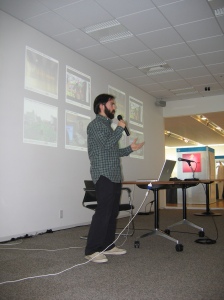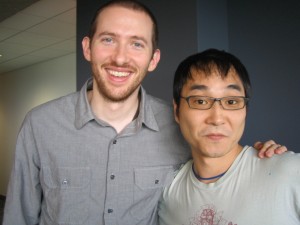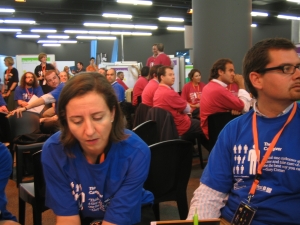
Max, Valerie, & Casey
Design + Community + Social Impact The Latest from GOOD Magazine and IDEO
1:55 pm – The conference hall at Midtown is filling up. Most of the audience looks to be under 30 – designers, students, people interested in sustainability. What is social design? That’s the title of the first session and we’ll be hearing from Max Schorr of GOOD Magazine.
2:10 The conference gets off to a start with welcoming remarks from JIDPO (Japan Industrial Design Promotion Organization) Project Department Director Shinji Yajima, Japan Society President Richard Wood, and Japan Foundation Center for Global Partnership executive director Sadaaki Numata. Everyone stresses the importance of people-to-people exchange for fostering innovation. CGP is one of Japan Society’s partners and supporters of the U.S.-Japan Innovators Network.
2:20 GOOD Magazine Co-Founder Max Schorr. ALTRUISM. The idea is to do good because you want to. GOOD wants to be in the middle space of pragmatic and idealistic. GOOD is not a binary proposition.

Max Schorr
2:25 Core values of GOOD – Transparency, creativity, authenticity, utility and … Love. Work + Love = Great Things. Max came to Tokyo about two years ago and met Rosanne Haggerty. Business used to be about loss and profit. Now harm and social value have become important points on the value axis. Products and opportunities that get consumers what they want but also provide social value: The new Walmart?
2:35 GOOD: Working with businesses to improve the world. There are models were consumers and businesses can exist in the same space to create social value. “Right now we’re in this interesting space of triple bottom line – money, social value and environmental impact”. How do you scale authenticity -? How do you reach the masses? Max thinks Obama’s a move in the right direction. You have to make good in people’s self interest. One way is to get global by being locally contextualized.
2:40 And Max adds: “It’s crucial always to have a sense of humor.” “I don’t want to be part of your revolution if I can’t dance.”
2:42 GOOD Co-Founder and Creative Director Casey Caplowe. YOU+ US = GOOD

Casey Caplowe
2:45 GOOD is a magazine, website – a lot of different things. For people who give a damn. Design isn’t just making things look cool but is about problem solving. Info graphics convey complex ideas. GOOD is a combination art project, problem-solving social networker, media machine. They’ve created a real community that’s collaborative and interactive.
3:10 Masaaki Ikeda, Creative Director, Tokyo Changemakers and Eco Plaza. The Evolution of Social Design in Japan. What is the future of social design in Japan? Japan lacks leadership – what does that bode for the future? Mr. Ikeda’s a bit older than Max and Casey. He talks about key people who influenced his journey. New Association Movement NAM – Sakamoto Ryuichi helped found this movement when he lived in New York. The start of social design in Japan? In 1997 the Kyoto Protocol and penetration of in the Internet had a big impact.
3:15 People where dancing in the streets in 1997. Kyoto Protocol – BIG BANG for the eco movement in Japan. NPOs started to spread in Japan after the Kobe earthquake. 1999 was a watershed year – THE YEAR OF SOCIAL ENTREPRENEURSHIP. “It was the first year we began to have a community currency.” NHK the broadcaster started to cover the idea of community currency. Michael Linton – LETS – Local Exchange Trading System. Ikeda’s magazine: KOKOKU. ADBUSTERS magazine. A Vancouver based anti consumerist magazine. An angry manifesto. “Fuck Committees”. FIRST THINGS FIRST.
3:25 “We should not waste our talent on frivolous products.” Ikeda was influenced by all this. Then he founded KOKOKU. Even money can be designed. “I wanted to make this the central concept of my magazine.” Read Michael Linton’s OPEN MONEY MANIFESTO. Make a community currency. “Money is just information…”. KOKOKU was in English and Japanese. There are seven issues and they were beautifully designed. “This magazine was a platform for social design activities.” DESIGN HAS THE POWER TO LEAD PEOPLE TO A BETTER FUTURE.
3:30 EARTH DAY. Bearded hippie throw-backs disbanded and brought in new blood. A NEW EARTH DAY 2001 with broader appeal. Rebirth Earth Day. Make every day Earth Day. Ikeda established Earth Day Money. 2002 – Candle Night. “We wanted to have an environmental movement that was global. Turn off the lights and light a candle and spend the night maybe praying”. Then came the “Sprinkling Water” campaign. Water on the pavement to cool down the earth.
3:40 Visit Eco Plaza. More trees bench? More trees design. It’s a system for reforestation. Japan has a lot of unattended forests. Ikeda: The forests need to be responsibly managed so they are sustainable. Cull trees, make useful products. And also tokyochangemakers. Venture capital, entrepreneurs.

Maasaki Ikeda
3:55 Valerie Casey, Leader, Digital Design Experience, IDEO & Founder, The Designers Accord. IDEO – A quick look at five projects.
1. American Red Cross – Why I Give (Blood). Who gets the blood? That was the focus of the ads. “Unappetizing”. IDEO redesigned the ads. People had an emotional connection but a better campaign is to give voice to the blood donors.

Valerie Casey
2. Healthcare. How doctors perform, how nurses work. IDEO redesigned the EMERGENCY ROOM experience. IDEO looked at NASCAR – triaging cars, triaging people. Clusters of activities… little kits, how to better treat patients.
3. Nokia. ENGAGE gaming platform. Make a better game.
4. Bank of America. In bill paying, people would round up when paying their bills to the next dollar. IDEO opened savings accounts for people who did this to help people save. $10 billion have been saved since 2005, $1 billion from the rounding.
5. 1/3 work at IDEO is social impact. Kick-start pump in Kenya. A light weight water pump you can take on your bicycle. Pump goes 18 meters into the ground and brings water up from the water table. Helps farms sustain and make a living. Many users are women. Design intervention. Recovered materials used – Aesthetic design? “Probably the ugliest thing IDEO has ever made”. But utilitarian.
4:05 Foundation of IDEO. Design Thinking. Think about the PEOPLE, the BUSINESS and the TECHNOLOGY. Design can solve any problem. The magic is to start with the PEOPLE FIRST. Subtle human behaviors are the key. IDEO uses its network. That’s how to make great impact. Open source philosophy – successes and failures. Always balance money with what your heart wants to do. “We are designers who are accidently good business people”.
4:10 Valerie: We’re in the business of designing CONSEQUENCES. The ipod has become the shorthand for success. The tyranny of the ipod. One client: “I want the ipod of diapers”. Zone of control and zone of influence. You need to tap into the zone of influence if we’re going to have social impact. Not just the beginning of the cycle.
4:15 “Green” – “Sustainability” Where do you start? Boring? Too hard? Giant jellyfish off the coast of Japan. She shows a faked Photoshopped image of a huge jellyfish. But there are real grotesque stories. A dead albatross with plastic in its stomach. Plastic sitting in the bottom of the ocean. ALL THE PLASTIC WE’VE EVER MADE IS STILL WITH US. Our earth is a closed system.
4:20 Designers Accord: Sustainability = Environmental impact + social impact. Army ants marching to their death… but we aren’t ants. Designers can make a difference. Designers Accord focuses on personal and communal accountability. 1) People and Places. Design schools educate and go green. 2) Everyone in DA has a conversation about sustainability with every customer and client that walks in their door. 3) Everyone in DA agrees to share their resources, best practices, foibles, etc with everyone else … a virtuous loop. July 2007… 450 People, 3 Countries, 4 Disciplines….now 150,000 people, 100 countries, all disciplines.
4:25 DA = Co-Create. How about a solar powered coffee maker? Solar panels in the shape of traditional tiles. Publish your carbon footprint so you can see what it looks like. Ask people in a public space to hand crank a wheel to generate light to understand the energy needed to generate electricity. People wrap a design school in recycled paper with the word WRONG. Stop thinking of design as the design of THINGS ONLY. The Aquaduct Team. A bicycle for transporting water.
Paul Hawken: “A lot of people – including me – wish the problem would go away but once you see it, it’s impossible to unsee.”

Q&A
How do you get people involved?
Casey: Spends his days thinking about this.
Max: This trip has re-energized us and meeting with greenz was very inspirational. Talked with Yugo Nakamura, the web designer and that was inspiring.
Valerie: Awareness does not always equate to action. That’s why the UN is failing; that’s why the Kyoto Protocol is failing. We need new models, different models than we have now.
Casey: I’ve learned that design, business, you have to view as means, not as ends. It’s the consequence, that matters. Self interest and the greater good – there’s a place where they overlap. Invent in THAT SPACE.
A question for Max: What is the definition of “designer”? And how does GOOD get income?
Max: I’m basic in my ability to create beautiful communications. But I do think of myself as a problem solver. GOOD revenue is advertising based.
A question for Casey: How do you maintain the quality of what you do?
Casey: It’s tapping into people who are doing the best work. GOOD layout and design is done by a small studio in NYC. Collaboration is key. Cherry pick the people who would be most fun to work with. We have a good project people want to be a part of. As GOOD grows, the community starts to create the content.
A question first to Valerie: In Japan I’m sure you met a of people, but give us something that impressed you about good design in Japan.
Valerie: People live so densely here with such civility. The architect Tsukamoto designs for small spaces. If design can make you want to live in a tiny 400 square foot space then it’s succeeding.
Casey: There’s a nice balance in Japan. Japan can be balanced and extreme at the same time.
Valerie: That’s a good point. In the US in many places it feel like the lowest common denominator. People in the US tend to speak down and not elevate the conversation.
Casey: We came here to talk about sustainable design. We always felt it had global importance. GOOD is largely focused in the US. So it’s amazing to hear similar ideas talked about here. What we thought was a global issue is definitively global.
(Daniel Rosenblum)
Read Full Post »

















